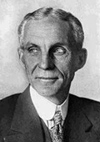 Born in Dearborn, Michigan, he enjoyed
tinkering withmachinery from a young age. While working for the Edison Illuminating Co., he experimented with internal combustion engines and "gasoline buggy" designs. Born in Dearborn, Michigan, he enjoyed
tinkering withmachinery from a young age. While working for the Edison Illuminating Co., he experimented with internal combustion engines and "gasoline buggy" designs.
In 1899 he left Edison to enter the
nascent automobile industry.After his initial venture folded, he formed the Ford Motor Company in 1903 and soon made it the undisputed industry leader. While other manufacturers saw cars as luxury items for the wealthy, Ford stressed efficient
mass productionof sturdy, affordable vehicles for the growing middle-class market. In 1908, he introduced the Model T, which dominated the industry for over a decade. In the 1920s, however, Ford fell behind its competitors in both technological development and consumer savvy (most famously, by its refusal to offer the Model T in any color but black). The introduction of the Model A in 1928 improved the company's standing, though it never regained the overwhelming market dominance of earlier years.
Ford's
rags-to-riches careermade him a capitalist folk hero to many. He reveled in his celebrity and pronounced his views on the great issues of the day. In 1915, he organized the "Ford Peace Ship," a group of
pacificistwho sailed to Europe in a vain attempt to mediate between the warring nations. In 1918, he lost a campaign for the Senate. In the 1920s, he published virulently
anti-Semiticarticles in company newspapers, and in the 1930s expressed admiration for Hitler.
Ford also took an innovative approach to labor relations, paying significantly higher wages than competitors but also fiercely, often violently, resisting unionization. By 1940, Ford had amassed a fortune in excess of one billion dollars, much of which he gave to charity through his
philanthropic foundations.
|
|
note:
tinker with
随随便便地修理,摆弄
nascent automobile industry:
刚开始起步的汽车产业
mass production:
大规模生产,批量生产
rags-to-riches career:
从赤贫走向暴富的事业
pacificist:
和平主义者,反战主义者
anti-Semitic: 反犹太主义
Semitic: adj. 闪米特人的
(包括犹太人、阿拉伯人、
古巴比伦人、古亚述人等),
有时特指犹太人
philanthropic foundations:
慈善基金
|
|
